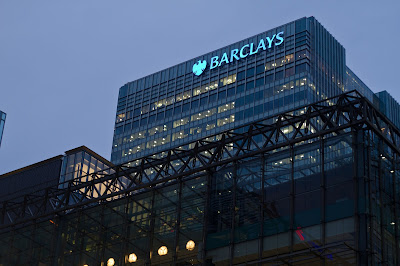Barclays’ Redevelopment Continues to Falter
We have looked at Barclays on quite a few occasions here in Financial Regulation Matters, and today’s
post continues with that theme. Following on from developments surrounding financial
penalties for the firm, and also the scandal involving Jes Staley and his
attempts to uncover
a whistleblower, recent news regarding the potential future for the Bank
deserve to be discussed as it continues to attempt to redevelop itself within
the post-Crisis era.
Earlier this month, the Bank made the headlines for
successfully ‘ring-fencing’ their consumer-focused element of the company,
which the Bank described as ‘the
biggest banking start-up ever’. In responding to the British Government’s
insistence that ‘the
largest UK banks must separate core retail banking from investment banking’,
the bank successfully completed the transfer of more than 24 million customer
accounts, which equated to more than £250 billion worth of assets. In addition,
which is extremely topical, the ring-fencing system also means that the
ring-fenced bank i.e. the element that is not subjected to the travails of the
risk-taking investment banking arm, will now be the vehicle to work with SMEs
who have an annual turnover of less than £6.5m. The move has been heralded by
onlookers (and the bank itself), with the bank stating that the separation
represents a ‘seismic’
but positive change, and external analysts suggesting that the divestment would
allow for ‘greater
balance sheet certainty’. However, a wider look at the fortunes of the
massive British-based bank suggest that challenging times lay ahead.
There are a number of potentially negative elements
currently affecting the bank, with each contributing to a negative outlook.
Firstly, the search is underway to replace
outgoing Chairman John McFarlane, which whilst significant in itself is
perhaps magnified with the increased
stake taken by the activist investor Edward Bramson; Bramson is renowned
for involving himself in the businesses within which he invests, which provides
for uncertainty in relation to the current issues faced by Barclays. With
regards to its leadership, Barclays CEO Jes Staley is still under investigation
for his alleged attempts to uncover the identity of a whistle-blower, which
although there has been some
support for Staley in the media with regards to his position on the matter,
continues to be a dark cloud hanging over the bank – if found guilty, it is
possible that Staley will be made to be an example (potentially). Additionally,
Staley has been praised
for his handling of the charges emanating from the US, with the Bank’s
settlement with the DoJ for $2 billion being regarded as a positive result for
the bank. Yet, others have not been so positive, and it has been argued that the
bank’s restructuring plans (strongly attributed to Staley) have not been
successful so far; one onlooker suggests that Bramson’s appearance on the
scene at Barclays is evidence
of this restructuring attempt failing. Furthermore, Barclays’ own audit
committee is continuing to raise fears over the culture
of compliance within the firm, which point towards a much larger issue.
Yet, those issues were all compounded recently by movement from the credit
rating agencies, whom we know so well here in Financial Regulation Matters.
Earlier this week, the Credit Rating giant Moody’s
downgraded Barclays to just one level above its so-called ‘junk status’. The
agency cited the ring-fencing manoeuvre as its biggest concern, suggesting that
whilst it believed the ring-fencing is positive, it has made
the bank riskier overall; there was a specific focus on the impact upon the
investment banking arm of the bank, which the agency believes could cause the
company serious harm if it suffers from the ring-fencing system. The business
media has been quick
to note that a. the downgrade was expected and b. it is having very little
effect upon the perceptions of investors towards the bank. However, there are
wider implications in that the pressure summarily increases on Staley at a time
where he needs anything but. Yet, it is fair to say that the bank is at
somewhat of a crossroads, and its development from this point could have a
major impact upon its long-term future.
There are a number of elements that will be concerning the
bank, but a few stand out. The credit rating downgrade makes for bad ‘optics’,
but the damage to the bank will likely be minimal before it is inevitably
raised to a ‘normal’ level. However, the two most concerning elements for the
bank are the emergence of Bramson, and the continuing investigation into
Staley. With Bramson increasing his stake, the possibility of this notorious
investor inserting himself into the business of the bank to satisfy his
objectives continue to increase, and that is not a positive for the bank; the
bank really needs to develop a longer-term focus to its operations, and many
have suggested that Bramson will look to do the exact opposite. For Staley, the
argument put forward in his defence (that the whistle-blower was not an
employee of the bank) may stand up under legal scrutiny, but is a poor defence
when one considers the effect of his actions upon the concept of
whistle-blowing more generally; not to re-hash an old
post, but with the prospect of ‘amnesia’ setting in within the financial
arena as we oscillate further away from the Crisis being a real possibility,
there is an acute need to champion the role of a whistle-blower – the question
is will allowing Staley to avoid sanction for his actions encourage such a
thing? The answer is no, and the effect of that will be massive. Yet, for Barclays,
their future is plagued by uncertainty at the moment, and it is important that
the bank’s development is kept in focus as it plots a way out of its current
malaise.
Keywords – Barclays, Banking, Business, UK, ring-fencing, @finregmatters





Comments
Post a Comment